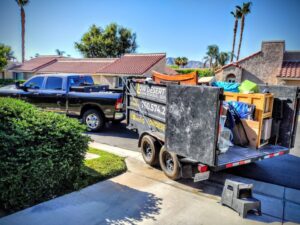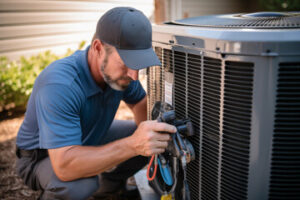Junk removal services help clear spaces that have become overwhelmed with clutter and waste. These services offer more than convenience—they support environmental responsibility. By streamlining how discarded materials are handled, they reduce the impact of careless disposal. The approach has shifted from simple pickup to strategic waste sorting and repurposing.

Modern junk removal services now prioritize sustainability and community impact. They no longer treat every discarded item as trash. Reusable furniture, appliances, and materials are assessed before they are hauled away. This mindset encourages resourcefulness and reduces unnecessary landfill contributions. Contact Temecula Dump for professional help.
Sorting is now an essential part of every removal process. Teams assess items on site and separate recyclables, donations, and waste. This reduces what ends up in traditional landfills. It also supports local initiatives that benefit from donated goods.
Some companies are using data to improve how junk is processed. Tracking what items are collected most helps refine removal plans. It also highlights trends in consumer disposal habits. These insights help create better waste management solutions over time.
Construction and renovation projects often require specialized junk removal. Debris like wood, drywall, and concrete must be sorted and hauled with care. Improper handling creates hazards and adds strain to public waste systems. Specialized crews manage this with skill and caution.
Offices and commercial spaces increasingly rely on junk removal during upgrades. Old desks, broken equipment, and unused files take up valuable space. Streamlining these environments improves workflow and employee satisfaction. Professional services make the transition smooth and efficient.
E-waste disposal has become a core concern in junk removal. Old devices contain materials that can damage ecosystems if not processed properly. Certified handlers dismantle electronics and ensure safe material separation. This protects both the environment and personal data.
Seasonal cleanouts are another major source of junk. Garages, attics, and basements often collect forgotten items throughout the year. Junk removal teams help restore these areas into usable spaces. They also eliminate safety risks from stacked or unstable materials.
Hoarding situations require a more sensitive approach. Junk removal professionals trained in compassion and discretion manage these projects. Their goal is to clear clutter without causing emotional distress. This work often includes coordination with health professionals or social workers.
Events such as festivals and large gatherings leave behind a surprising volume of waste. Junk removal crews help restore venues by handling discarded items swiftly. These efforts prevent overflow and maintain cleanliness standards. They also contribute to smoother event logistics and safety.
Mobile apps are changing how junk removal is scheduled and managed. Users can book pickups, upload photos of items, and get quotes instantly. This increases accessibility and reduces response time. Digital tools now shape the entire customer experience.
Some junk removal providers now offer on-demand sorting and repurposing units. These mobile units assess and process items right on the spot. They reduce the need for multiple trips and boost overall efficiency. Innovation in this space continues to evolve quickly.
Reclaimed materials from junk removal often find second lives in creative projects. Wood from broken furniture becomes part of new designs. Metal scraps are repurposed for art or construction. What was once seen as junk now becomes a source of inspiration.
Junk removal plays an important role in reducing illegal dumping. When reliable services are available, fewer people resort to unsafe methods. Communities benefit from cleaner streets and healthier ecosystems. Visibility and education help spread this awareness.
Downsizing during life transitions often requires professional help. Whether moving to a smaller home or clearing out after a loss, junk removal becomes necessary. These services provide both physical support and emotional relief. Their role during such moments cannot be understated.
Junk removal also supports businesses in keeping up with health codes. Accumulated waste can lead to pest infestations or blocked exits. Routine clearing ensures compliance and maintains a professional atmosphere. It also boosts morale among staff and customers.
Storage units are common sources of long-forgotten items. Junk removal crews assist in clearing these spaces quickly and carefully. They also help clients determine what to keep, donate, or discard. This speeds up the decluttering process and reduces stress.
Some junk removal teams now specialize in eco-education. While collecting waste, they inform clients about sustainable habits. This turns every service into an opportunity for change. Small shifts in disposal habits lead to broader environmental impact.
Shared living spaces also benefit from routine junk pickup. In apartment buildings and dorms, common areas gather unclaimed or broken items. Regular removal prevents fire hazards and improves shared comfort. Property managers increasingly see this as essential upkeep.
Junk removal is also critical for real estate preparation. Before a property is listed, it must be clean and presentable. Clutter-free homes attract buyers faster and sell at better prices. These services add value long before a sale happens.
Emergencies like floods and fires create sudden needs for junk removal. Damaged belongings must be cleared to begin repairs. Speed is critical in these situations to reduce mold and structural decay. Specialized teams respond quickly to stabilize the environment.
Urban areas face unique junk challenges due to limited space. Alleyways and shared streets can become cluttered rapidly. Timely junk removal keeps pathways clear and neighborhoods safe. It also improves urban aesthetics and accessibility.
Rural communities also benefit from junk services despite having more land. Remote locations may lack public disposal access. Junk removal companies offer essential support in managing waste properly. This ensures safety and environmental compliance even in isolated areas.
Pop-up junk stations are being tested in busy neighborhoods. These temporary hubs allow people to bring items for sorting and disposal. They reduce illegal dumping and improve awareness. When successful, they become recurring services supported by the community.
Junk removal is also being integrated into disaster recovery plans. After storms or earthquakes, debris clogs streets and properties. Coordinated clearing helps restore order and safety faster. These efforts often include collaboration with relief organizations.
Educational institutions benefit from bulk junk removal during renovations. Old desks, bookshelves, and electronics are common discards. Clearing these quickly ensures classes resume on time. The process is fast, thorough, and minimally disruptive.
Junk removal also assists in improving mental wellness. Clutter has been shown to increase stress and reduce focus. Creating clear, open environments supports calm and productivity. Services that restore order indirectly improve quality of life.
Some junk removal teams now collect data to improve operations. They track item categories, pickup frequency, and disposal results. These reports help optimize routes and reduce emissions. Insights also guide public education efforts on waste habits.
Donation partnerships have become a vital part of junk services. Items in good condition are redirected to charities or reuse centers. This approach strengthens communities and promotes sustainability. It gives junk a second life where it’s truly needed.
Regulations around junk disposal are also evolving. Some regions now fine for improper handling or dumping. Certified junk services help clients stay compliant. Knowledge of local policies ensures safe and legal removal every time.
Packaging waste from online shopping has increased demand for junk removal. Boxes, foam, and wrapping materials pile up quickly. Routine pickups help manage this influx. This keeps homes neat and prevents packaging from ending up in waterways.
Junk removal plays a subtle but powerful role in circular economies. It closes the loop between disposal and reuse. Each cleared item is a chance to reduce consumption and waste. The ripple effect of this mindset benefits both people and planet.
As urban density increases, space becomes more valuable than ever. Removing junk frees up storage, living, and working areas. Clean environments offer room for growth, creativity, and movement. Junk removal is not just a service—it’s a tool for transformation.
The evolution of junk removal reflects changing values around waste and sustainability. It’s no longer just about clearing trash. It’s about reclaiming space, protecting nature, and supporting better habits. With every pickup, the path to a cleaner future becomes clearer.
